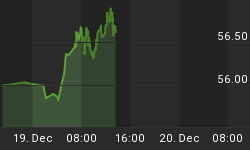It gets increasingly difficult to write a comment about the macroeconomy and the market implications thereof when the macroeconomic developments have ceased to have any important effect on the market. Every market bet now is a bet on the Fed: bonds, stocks, TIPS, commodities, the dollar...everything. So who cares about the data?
To be sure, I am one of those who believes that the better-than-expected Existing Home Sales number we saw today (4.53mm versus 4.30mm expected) is nothing to get excited about when the '08-'09 low was 4.53mm, but ordinarily such a positive surprise can be counted on to jazz equities and razz bonds. Today, there was hardly a ripple.
The 5y TIPS reopening came at -0.55% real yield, which provoked many dramatic headlines about how this was the first ever negative yield for a Treasury auction. Those of us who live and breathe in the inflation-linked markets are accustomed to this sort of real-nominal confusion. In truth, there is nothing particularly extraordinary about an auction clearing at a negative real yield, and in fact there have been many, many Treasury auctions that cleared at a negative real yield. Apples to apples, folks - the most-recent nominal 3y Treasury note auction cleared at 0.569% on October 12th. The 3y inflation swap was 1.50% on that day, so that auction cleared at a -0.931% real yield. Treasury Bill auctions routinely occur at sharply negative real yields; the only thing unique about a TIPS auction is that the real yield, and not the nominal yield is reported. There is nothing remarkable about the level of today's TIPS auction.
Another way to think about it is this:
Treasuries will pay (required real yield + a priori expected inflation)
TIPS will pay (required real yield + actual ex post inflation)
With nominal Treasuries, since we're setting in advance both the real yield and the expected inflation, the practice is to report the sum of the two rates. But that doesn't mean an investor in Treasuries doesn't care about the real rate he's getting!
TIPS are very probably not expensive but on the contrary cheap to Treasuries, at these negative yields - at the short end of the curve, at least. The 5y TIPS at this level will perform better over its life than the 5y Treasury note as long as inflation averages 1.75% or more over the next 5 years (that is, as long as ex post realized inflation turns out to be greater than a priori expected inflation). As with the economic data, this bet boils down to whether the Fed can achieve the level of inflation (or the price level) that it desires. The folks buying the 5y TIPS believe that it can. (Circling back to the Existing Home Sales numbers, inventory is now above 4mm units, making such a bet on inflation more problematic in the short-term but five years is a lifetime in monetary policy - see Friday's comment).
Inflation swaps widened after the successful auction (2.84 bid:cover was pretty good for the first ever auction that cleared at a negative real yield that we didn't have to do math to see), increasing 2-6bps with the best performance around the 5y point.
Looking forward to tomorrow, the economic data that we will all ignore includes the Case Shiller Home Price Index (expected to be +2.10% on the Composite-20 y/y, down from 3.18% last month) and the FHFA Home Price Index (Consensus: -0.2% month-on-month vs -0.5% last), along with Consumer Confidence (Consensus: 49.9 from 48.5. Continue to watch the Jobs-Hard-To-Get subindex, which is a great coincident/short leading index of the Unemployment Rate and which rose last month to 46.1).
And regardless of that data, the bond and equity markets are both looking tired to me. With just one week to go before the election and another day after that before the presumptive QE2 kicks off, I wonder when the risk-shedding will begin. The technical indicators seem to warn of ebbing momentum and trend-followers have lots of profits to take. A six-month, 160bp rally like we have seen in the 10y note from April to October is not common, especially once we are well into a recession: we had such a rally in 2007 extending into early 2008 as the market realized the parlous economic state we were in and began to price it in, and of course in 2008 we had a bigger rally over a shorter period of time. In 2002 there was a similar-scale rally, albeit from higher yields. That is the entire roster of such rallies over the last decade. Yes, yields are 17bps above their low ebb, but this is one pullback I think could extend much further.
.
A quick reminder: my book is finally available on Kindle. I will be getting around to putting it on the iPad soon; let me know if there is another e-book distributor where you'd like to see it offered.















